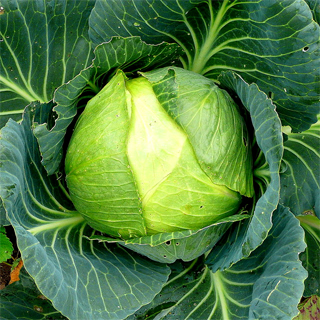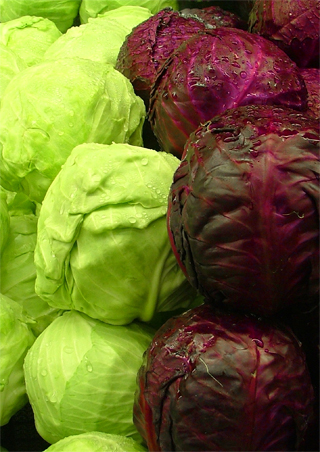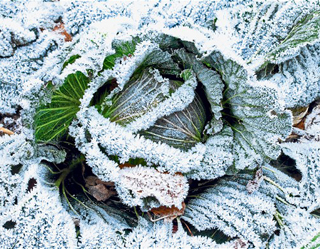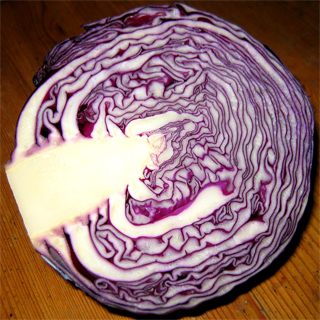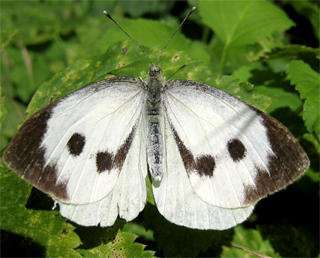
Growing the Best Cabbage in Oregon, Washington and British Columbia
The versatile cabbage (Brassica oleracea) offers a high nutritional yield per square foot of garden space and is well adapted to the Pacific Northwest. It is one of the most widely cultivated vegetables in the world. The edible cabbage head is actually the plant’s unopened flower bud and will bloom and seed if left until the following year.
Although wild cabbage relatives are found worldwide, the common domestic cabbage was reputedly brought to America in the 1600’s by French-Canadian explorer Jacques Cartier.
Like most brassicas, cabbage is a cool weather crop, best grown in spring and fall in the Northwest and able to overwinter in mild years.
In addition to red, green and purple standard size heads, unusual varieties include huge round “kraut” heads, crinkly-leaved savoy types, bok choy (Chinese cabbage,) oblong –shaped Napa cabbage and the spicy “Gonzales” type with tiny 4”-6” heads.
Early varieties of cabbage mature in 60-75 days and while late types may take up to 120 days.
Shred the versatile plant for green salads and coleslaw (savoy types are especially good for slaw,) add to sautés and casseroles, or ferment for sauerkraut or kimchi.
Cabbage and Your Health
- Cabbage is high in vitamin C and other cancer-fighting /anti-aging antioxidants and in essential minerals like potassium, manganese, iron, and manganese.
- It is also high in B-complex vitamins and vitamin K, which is necessary for strong, healthy bones.
- Red cabbage is a good source of anti-inflammatory phytonutrients. Red cabbage also contains six to eight times more vitamin C than green cabbage and a cup contains nearly 70% of the recommended daily amount.
- Steamed cabbage has more cholesterol-lowering ability than raw cabbage.
- One cup of cooked red cabbage also contains 79% of your daily vitamin K and 20% of vitamin B6.
- Cabbage is on this list of the World’s Healthiest Foods.
- One study showed impressive reduction of breast cancer risk in women consuming large amounts of cabbage.
.Seasonal Guide
Early spring:
- If using transplants, start seeds indoors in 4” pots.
Spring:
- Prep beds
- Direct sow early maturing types outdoors in early March in the Pacific NW for early summer harvest.
- Continue successive sowing every two weeks until early summer.
- Harden off transplants and set out in bed.
- Mulch between rows and consider adding a floating row cover to keep out insect pests.
Summer:
- Sow later maturing types from late May to early July for fall harvest and winter storage.
- Keep rows weed-free
- Side-dress with liquid fertilizer every 2-3 weeks.
Fall:
- Harvest late maturing varieties.
- Compost damaged outer leaves and stems.
- Plan on rotating to a new bed in the spring.
- Start overwintered varieties in September for harvest in April or May. Cover with a coldframe through the winter.
Location
Choose a fertile, sunny location with lots of organic matter for these heavy feeders. Avoid swampy or low-lying areas where moisture will encourage disease. Again, crop rotation is essential with all brassicas for disease control.
Soil prep
Till in lots of finished compost to make a rich loam. Small-headed varieties will appreciate the addition of some clean sand to lighten the soil. Heavy soil is alright for most types of cabbage, as long as it is well-drained at the surface. Cabbages thrive in well-limed soil, so test for PH and add lime as needed.
Planting
Direct sow as soon as soil can be worked in spring, usually in early March in the PNW. Sow seed ¼” deep, 4”-6” apart in rows 2’-3’ apart. Cover and water lightly, avoiding heavy splashing which will cause soil to crust over and hinder germination.
When seedlings have 4-5 true leaves, thin to one plant every 18”-24”.
If using transplants, set out at the final spacing of 18”-24”.
Once plants have a few true leaves, they will be quite tolerant of light frosts and other climactic changes. Until then, use row covers or cloches to protect tender plants if weather turns nasty.
Speed growth with a side-dressing of high nitrogen fertilizer when planting and again every 2-3 weeks. After the Spring slug population has declined with warmer weather mulch rows with straw to keep soil cool and to retain moisture.
Weed carefully, as some roots will stay very close to the surface.
Water
Cabbage will put down a deep tap root to bring moisture and nutrients up from as far as three feet below the soil surface, so a once-weekly deep soaking is preferable to frequent sprinkling.
Even watering will encourage nicely formed heads, while moisture fluctuations will cause splitting and lopsided heads.
Diseases and Pests
Cabbages, like most brassicas, are susceptible to a number of insect pests and afflictions. The application of a floating row cover beginning when the plants are small will keep many insects out.
Treat aphids and flea beetles (look for pin-holes in leaves) with soapy water spray or Pyrethin.
Cabbage moths lay eggs on the undersides of leaves. The caterpillars hatch and feed on leaves and roots, causing severe damage if untreated. Spraying with Bt (Bacillus thuringiersis) is easy, non-toxic and should be done every couple of weeks.
Cabbage root maggot is often the most difficult pest to control. These 1/4″, yellowish white larvae live in the soil and eat cabbage rots that cause sudden wilting. Maggot populations are highest in April and May so not planting in those months can avoid trouble. Floating row covers are very effective if placed immediately after sowing seed or transplanting seedlings.
A ring of sawdust 1 1/2″ deep and eight inches wide around each plant will keep the cabbage maggot fly from laying eggs in the soil. To be effective the sawdust must cover the soil and touch the stem – refresh sawdust every couple of weeks.
Root maggots can also be controlled with beneficial nematodes – a tiny worm-like parasite that preys on many soil pests. As a last resort, root maggots can be controlled by a pyrethrin drench around the plant.
Harvest
Pick early types when they are firm and soft-ball size. Harvest them early to prevent bursting. Late head varieties can be left in the field longer. Cut the stalk directly under the head for immediate use; leave 3” or so of stem if heads are to be stored. Remove damaged leaves and place separately on shelves in a cold room or cellar. Traditionally, each head was wrapped in wax paper or put into its own brown paper bag for storage.
